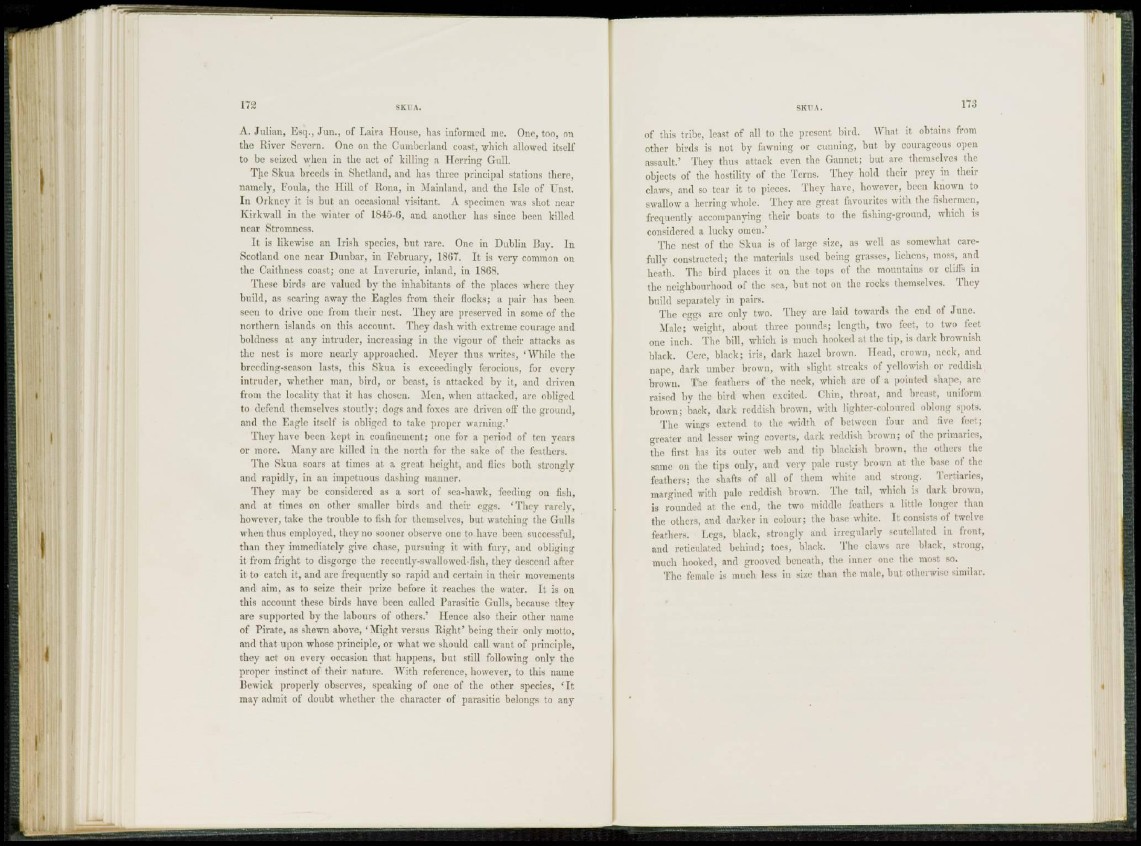
A. Julian, Esq., Jun., of Laira House, has informed me. One, too, on
the River Severn. One on the Cumberland coast, which allowed itself
to be seized, when in the act of killing a Herring Gull.
The Skua breeds in Shetland, and has three principal stations there,
namely, Foula, the Hill of Rona, in Mainland, and the Isle of ITist.
I n Orkney it is but an occasional visitant. ,\ specimen was -hot near
Kirkwall in the winter of 1845-6, and another has since been killed
near Stromncss.
I t is likewise an Irish species, but rare. One in Dublin Bay. In
Scotland one near Dunbar, in February, 1867. It is very common on
the Caithness coast; one at Inverurie, inland, in 1868.
These birds arc valued by the inhabitants of the places where they
build, as scaring away the Eagles from their flocks; a pair has been
seen (o drive one from their nest. They an; preserved in some of the
northern islands on this account. They dash with extreme courage and
boldness at any intruder, increasing in the vigour of their attacks as
the nest is more nearly approached. Meyer thus writes, 'While the
breeding-season lasts, tins Skua is exceedingly ferocious, for every
intruder, whether man, bird, or beast, is attacked by it, and driven
from the locality that it has chosen. Men, when attacked, are obliged
to defend themselves sfoutlv; dogs and foxes are driven off the ground,
and the Eagle itself is obliged to take proper warning.'
They have been kept in confinement; one for a period of ten years
or more. Many are killed in the north for the sake of the feathers.
The Skua soars at times at a great height, and flics both strongly
and rapidly, in an impetuous dashing manner.
They may be considered as a sort of sea-hawk, feeding on fish,
and at times on other smaller birds and their eggs. 'They rarely,
however, take the trouble to fish for themselves, but watching the Gulls
when thus employed, they no sooner observe one to have been successful,
than thev immediately give chase, pursuing it with fury, and obliging
it from fright to disgorge the recently-swallowed-fish, they descend after
it to catch it, and arc frequently so rapid and certain in their movements
and aim. as to seize their prize before it reaches the water. It is on
this account these birds have been called Parasitic Gulls, because they
are supported by the labours of others.' Hence also their other name
of Pirate, as shewn above, ' Might versus Right' being their only motto,
and that upon whose principle, or what we should call want of principle,
they act on every occasion that happens, but still following only the
proper instinct of their nature. With reference, however, to this name
Bewick properly observes, speaking of one of the other species, ' It
may admit of doubt whether the character of parasitic belongs to aoy
of this tribe, least of all to the present bird. What it obtains from
other birds is not by fawning or cunning, but by courageous open
assault.' They thus attack even the Gannet; but are themselves the
objects of the hostility of the Terns. They hold their prey in their
claws, and so tear it to pieces. They have, however, been known to
swallow a herring whole. They are great favourites with the fishermen,
frequently accompanying their boats to the fishing-ground, which is
considered a lucky omen.'
The nest of the Skua is of large size, as well as somewhat curefully
constructed; the materials used being grasses, lichens, moss, and
heath. The bird places it on the tops of the mountains or cliffs in
the neighbourhood of the sea, but not on the rocks themselves. They
build separately in pairs.
The eggs are only two. They are laid towards the end of June.
Male; weight, about three pounds; length, two feet, to two feet
one inch. The bill, which is much hooked a t the tip, is dark brownish
black, (.'ere, black; iris, dark hazel brown. Head, crown, neck, and
nape, dark umber brown, with slight streaks of yellowish or reddish
brown. The feathers of the neck, which arc of a pointed shape, are
raised by the bird when excited. Chin, throat, and breast, uniform
brown; back, dark reddish brown, with lighter-coloured oblong spots.
The wings extend to the -width of between four and five feet;
greater and lesser wing coverts, dark reddish brown; of the primaries,
the first has its outer web and tip blackish brown, the others the
same on the tips only, and very pale rusty brown at the base of the
feathers; the shafts of all of them white and strong. Tertiaries,
margined with pale reddish brown. The tail, which is dark brown,
is rounded at the end, the two middle feathers a little longer than
the others, and darker in colour: the base white. It consists of twelve
feathers. Legs, black, strongly and irregularly scutellatcd in front,
and reticulated behind; toes, black. The claws are black, strong,
much hooked, and grooved beneath, the inner one the most so.
The female is much less in size than the male, but otherwise similar.